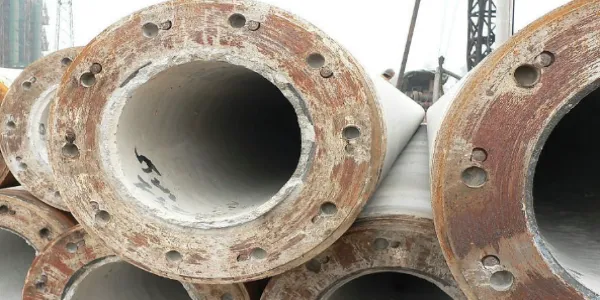Steel pipe piles have become an important part of deep foundation engineering due to their simple structure, easy use, good sealing, high strength and good elasticity. Their service life is of great significance to engineering design, cost budget and long-term maintenance planning. In general, the service life of steel pipe piles can reach about 30 to 50 years, but their specific service life will be affected by many factors.
1. Types and common forms of steel pipe piles
Steel pipe piles are a commonly used pile foundation form, usually with a larger diameter, ranging from 16 inches to 60 inches. This type of heavy steel pipe can be manufactured by
longitudinal welding (LSAW) or
spiral welding (SSAW) technology. Depending on the soil environment used, the surface of the steel pipe can be treated with anti-corrosion treatment, such as galvanizing, FBE (fusion bonded epoxy powder coating) or 3LPE (three-layer polyethylene coating). These coatings help improve the moisture and corrosion resistance of steel pipe piles, thereby extending their service life.
The types of steel piles commonly used in engineering construction currently include steel pipe piles, special-shaped steel piles and steel sheet piles. Among them, steel pipe piles show unique advantages with their high bending stiffness and single pile bearing capacity. |-shaped steel piles and H-shaped steel piles in special-shaped steel piles can not only withstand vertical loads, but also horizontal loads, and are a common cross-sectional shape.
2.Typical Service Life of Steel Pipe Piles
The service life of steel pipe piles depends on several variables, including material quality, coating system, soil conditions, and maintenance. On average, properly installed and protected steel pipe piles can last 50 to 100 years, and in some cases, even longer.
Here’s a general breakdown:
|
Environment
|
Expected Service Life
|
|
Freshwater immersion
|
60–80 years
|
|
Saltwater or marine exposure
|
40–70 years (with coating)
|
|
Subterranean (dry)
|
80–100 years
|
|
Industrial urban soils
|
50–75 years
|
These lifespans assume that the steel pipe piles are either naturally protected (e.g., embedded deep in non-aggressive soils) or treated with corrosion-resistant coatings or cathodic protection systems.
3. Factors affecting the life of steel pipe piles
Material characteristics
The raw material of steel pipe piles is generally steel, and the quality of the material is the key factor in determining its life. High-quality steel can not only improve the strength of the metal, but also enhance its corrosion resistance. In some special environments, such as marine environments, it is particularly important to use materials with high corrosion resistance.
Construction quality
The life of steel pipe piles is closely related to the construction quality. If the pile body tilts or cracks during construction, it will directly affect the service life of the pile. Therefore, during construction, the operating specifications must be strictly followed to ensure the verticality and integrity of the piles.
Use environment
The use environment of steel pipe piles also has a significant impact on their lifespan. Factors such as humidity, temperature, and corrosive media will cause varying degrees of corrosion or damage to steel. In the marine environment, steel pipe piles need to have good seawater corrosion resistance to prevent their lifespan from being shortened due to corrosion. Anti-corrosion treatment is particularly important for areas where soil moisture is high or contains corrosive substances.Soil pH, salinity, moisture content, and the presence of stray currents or microbial activity can all accelerate corrosion. Conducting a geotechnical survey before pile installation is critical.
Pile Thickness and Steel
Grade Thicker pipes and higher-grade steels, such as ASTM A252 Grade 3 or API 5L X65, provide more resistance to mechanical and chemical degradation, increasing the lifespan of steel pipe piles.
Installation Method
Improper driving or welding during installation can damage protective coatings or create weak spots, leading to early failure. Quality control during pile driving is essential.
Maintenance and Monitoring
Periodic inspection, especially for exposed marine piles, helps detect corrosion or damage early. Maintenance strategies such as coating reapplication or cathodic protection can add decades to a pile's service life.
4.How to Maximize the Service Life of Steel Pipe Piles
To ensure the long-term performance of steel pipe piles, follow these proven strategies:
Choose the Right Steel Grade: Use high-strength, corrosion-resistant steel tailored for your project’s environmental conditions.
Apply High-Performance Coatings: Use marine-grade epoxy or fusion-bonded epoxy (FBE) coatings to resist corrosion in harsh environments.
Implement Cathodic Protection: Particularly for underwater piles, this system uses sacrificial anodes to reduce corrosion.
Monitor and Inspect Regularly: Use ultrasonic testing and corrosion sensors to detect early-stage damage and respond quickly.
Design for Redundancy: Engineering a safety factor into the pile diameter or wall thickness ensures the structure remains sound even under extreme conditions.
5.Comparing Steel Pipe Piles with Other Foundation Types
|
Foundation Type
|
Durability
|
Load Capacity
|
Cost
|
Installation Speed
|
|
Steel Pipe Piles
|
High (50–100 yrs)
|
Excellent
|
Moderate to High
|
Fast
|
|
Concrete Piles
|
Moderate (40–70 yrs)
|
Good
|
Moderate
|
Slower
|
|
Timber Piles
|
Low (20–50 yrs)
|
Low to Moderate
|
Low
|
Fast
|
This comparison shows why steel pipe piles remain the top choice for projects requiring strength, longevity, and performance in challenging environments.
4. Conclusion
If you're looking for a long-lasting, high-performance foundation solution, steel pipe piles offer unparalleled durability and versatility. Their service life can exceed 100 years when designed and maintained properly, making them a wise investment for critical infrastructure and offshore applications.
Whether you're working on a large-scale port project or a commercial high-rise in an urban environment, choosing the right steel pipe piles and implementing proper corrosion protection strategies can significantly enhance your structure's lifespan and safety.






 English
English Español
Español بالعربية
بالعربية











 Phone :
Phone :  Whatsapp :
Whatsapp :  Email :
Email : 


